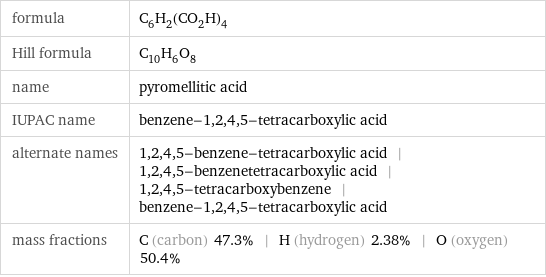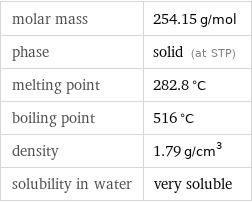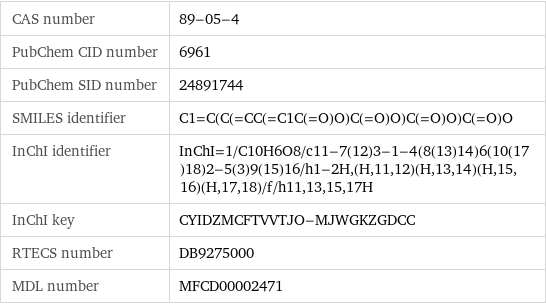Input interpretation

pyromellitic acid
Chemical names and formulas

formula | C_6H_2(CO_2H)_4 Hill formula | C_10H_6O_8 name | pyromellitic acid IUPAC name | benzene-1, 2, 4, 5-tetracarboxylic acid alternate names | 1, 2, 4, 5-benzene-tetracarboxylic acid | 1, 2, 4, 5-benzenetetracarboxylic acid | 1, 2, 4, 5-tetracarboxybenzene | benzene-1, 2, 4, 5-tetracarboxylic acid mass fractions | C (carbon) 47.3% | H (hydrogen) 2.38% | O (oxygen) 50.4%
Lewis structure

Draw the Lewis structure of pyromellitic acid. Start by drawing the overall structure of the molecule, ignoring potential double and triple bonds: Count the total valence electrons of the carbon (n_C, val = 4), hydrogen (n_H, val = 1), and oxygen (n_O, val = 6) atoms: 10 n_C, val + 6 n_H, val + 8 n_O, val = 94 Calculate the number of electrons needed to completely fill the valence shells for carbon (n_C, full = 8), hydrogen (n_H, full = 2), and oxygen (n_O, full = 8): 10 n_C, full + 6 n_H, full + 8 n_O, full = 156 Subtracting these two numbers shows that 156 - 94 = 62 bonding electrons are needed. Each bond has two electrons, so in addition to the 24 bonds already present in the diagram add 7 bonds. To minimize formal charge oxygen wants 2 bonds and carbon wants 4 bonds. Identify the atoms that want additional bonds and the number of electrons remaining on each atom: Fill in the 7 bonds by pairing electrons between adjacent highlighted atoms. Note that the six atom ring is aromatic, so that the single and double bonds may be rearranged: Answer: | |
3D structure

3D structure
Basic properties

molar mass | 254.15 g/mol phase | solid (at STP) melting point | 282.8 °C boiling point | 516 °C density | 1.79 g/cm^3 solubility in water | very soluble
Units

Hydrophobicity and permeability properties

predicted LogP hydrophobicity | 0.8 predicted LogS | -2.59
Basic drug properties

approval status | experimental | small molecule
Solid properties (at STP)

density | 1.79 g/cm^3 vapor pressure | 1.5×10^-14 mmHg (at 25 °C)
Units

Thermodynamic properties

molar heat of combustion | 3255 kJ/mol specific heat of combustion | 12.81 kJ/g (at STP)
Chemical identifiers

CAS number | 89-05-4 PubChem CID number | 6961 PubChem SID number | 24891744 SMILES identifier | C1=C(C(=CC(=C1C(=O)O)C(=O)O)C(=O)O)C(=O)O InChI identifier | InChI=1/C10H6O8/c11-7(12)3-1-4(8(13)14)6(10(17)18)2-5(3)9(15)16/h1-2H, (H, 11, 12)(H, 13, 14)(H, 15, 16)(H, 17, 18)/f/h11, 13, 15, 17H InChI key | CYIDZMCFTVVTJO-MJWGKZGDCC RTECS number | DB9275000 MDL number | MFCD00002471
Safety properties

lower explosive limit | 1.2% (concentration in air) upper explosive limit | 7.8% (concentration in air)
Toxicity properties

RTECS classes | other